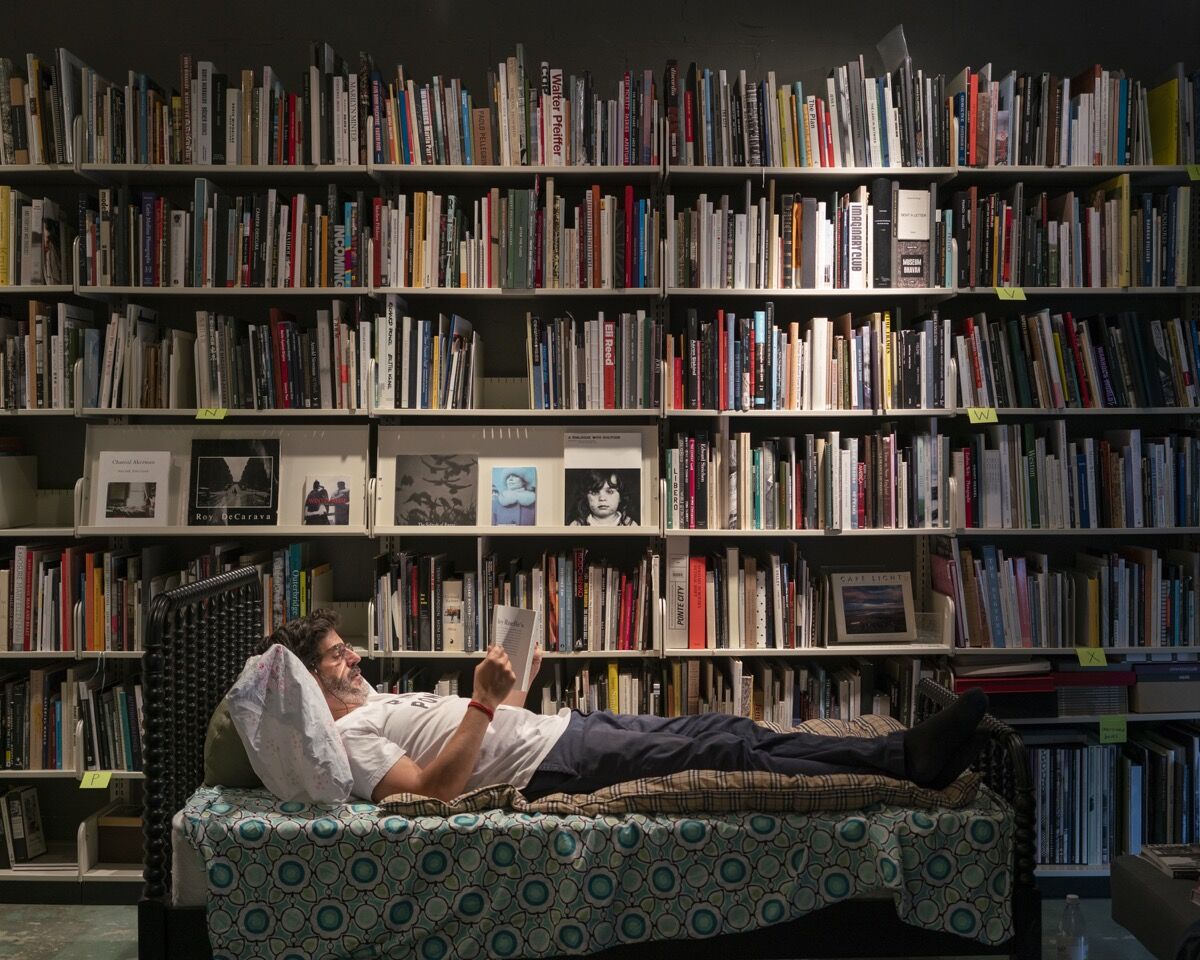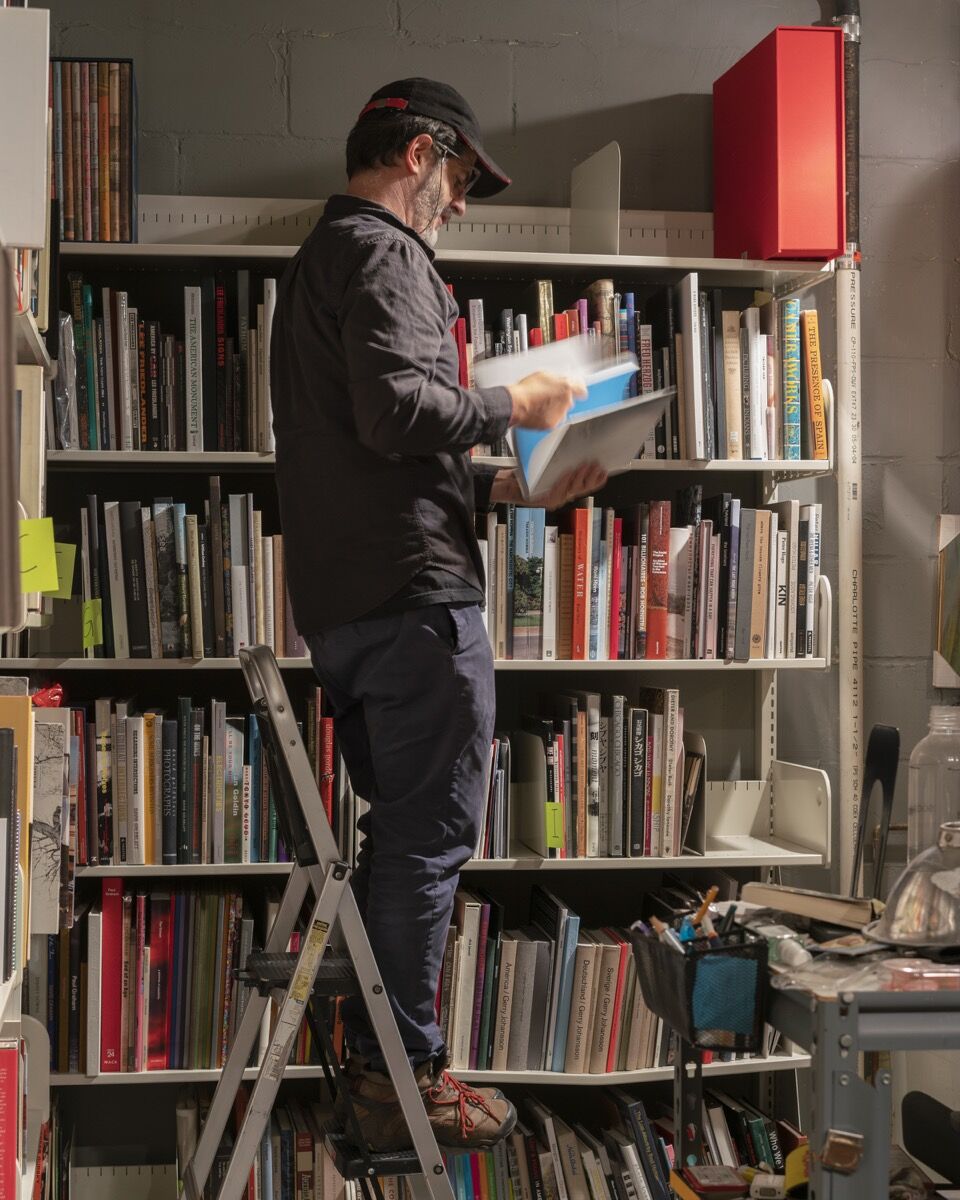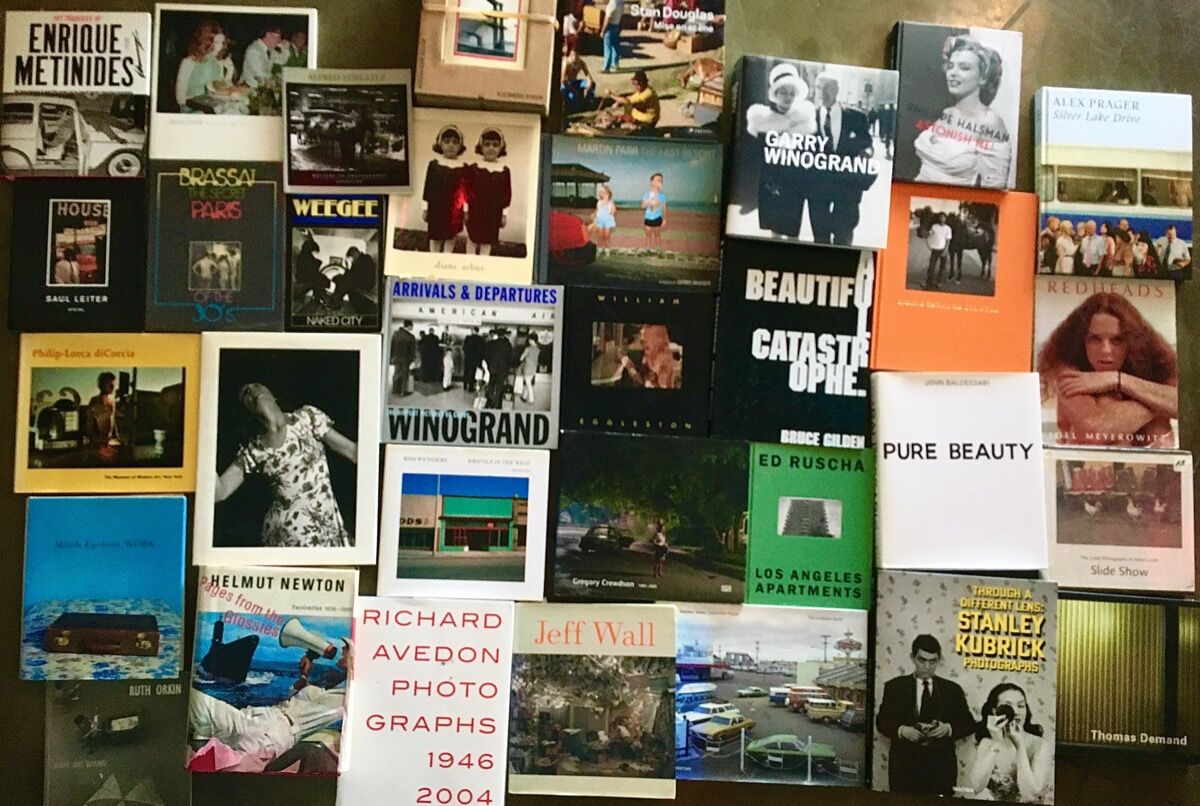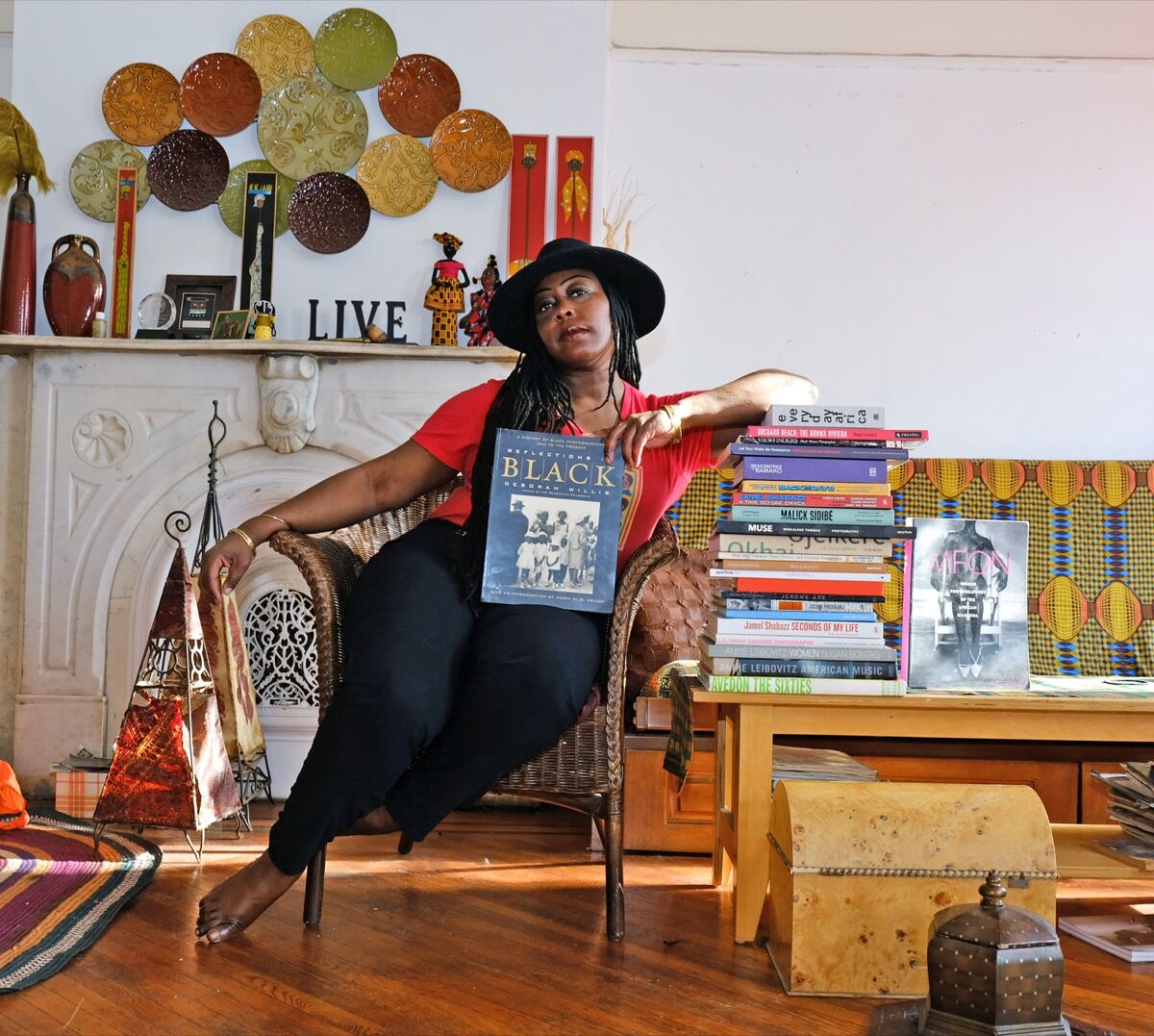https://www.artsy.net/article/artsy-editorial-5-celebrated-photographers-share-favorite-photo-books?utm_medium=email&utm_source=19037032-newsletter-editorial-daily-12-31-19&utm_campaign=editorial&utm_content=st-S





Art Market
5 Celebrated Photographers Share Their Favorite Photo Books

Alec Soth in his photo book library. Photo by Ethan Jones.
All photographers remember the magic of the first camera they owned, but another transformative experience is often the first photography book that kindled a flame within them. Photographers’ books are rarely hidden away or untouched, but rather combed through frequently, and loved.
“My photo book collection is arranged in stacks in my living room, in a way that encourages visitors to my home to look and enjoy them,” said documentary photographer
.
.
Stains, yellowed pages, and worn bindings might make the rare book collector balk. But fine-art photographer
often becomes deeply attached to his copies precisely because of their imperfections. “I love the worn parts of them—this clipped corner on [
’s] Uncommon Places,” he said, or a stain on his copy of ’s Summer Nights (1985). “It's just the memory and the tactile quality of the book. I remember pulling it from my bookshelf, when I first fell in love with it.”
often becomes deeply attached to his copies precisely because of their imperfections. “I love the worn parts of them—this clipped corner on [
’s] Uncommon Places,” he said, or a stain on his copy of ’s Summer Nights (1985). “It's just the memory and the tactile quality of the book. I remember pulling it from my bookshelf, when I first fell in love with it.”
Here, five renowned photographers take us inside their photo book collections.
Alec Soth

Alec Soth in his photo book library. Photo by Ethan Jones.
One of Soth’s earliest photo books was the stained copy of Adams’s Summer Nights. He bought it before he considered his handful of books a collection. Today, he said, “the Robert Adams shelf is a heavy one.”
Soth has collected around 5,000 books, but he still doesn’t consider what he does “collecting” in a formal sense. “I'm not obsessive about first editions, or untouched books. Not everything needs to be signed,” he said.
When Soth began earning international recognition for his work, he was able to travel to book fairs; form relationships with publishers; and start an experimental imprint, Little Brown Mushroom. His own publisher, Mack Books, released his latest book, I Know How Furiously Your Heart is Beating, earlier this year, as well as a reprint in 2017 of his formative 2004 monograph Sleeping by the Mississippi.
Soth has been heavily influenced by classic U.S. photo books like
’s Message from the Interior (1966), and Shore’s Uncommon Places (1982), but he also seeks out niche books that have unusual relationships between image and text. He became fascinated by the subgenre of photographic children’s books—Dare Wright’s The Lonely Doll (1957) being among the most famous—as well as photo-based comic books. “I have lots of obscure artists’ books and zines that use image and text in funny ways,” he said.
’s Message from the Interior (1966), and Shore’s Uncommon Places (1982), but he also seeks out niche books that have unusual relationships between image and text. He became fascinated by the subgenre of photographic children’s books—Dare Wright’s The Lonely Doll (1957) being among the most famous—as well as photo-based comic books. “I have lots of obscure artists’ books and zines that use image and text in funny ways,” he said.
His most treasured photo book was an unlikely find. Over two decades ago he was sifting through a Barnes and Noble sales bin when he came across the U.S. edition of
’s The Solitude of Ravens (1991), an obsessive, poetic study of ravens that reflected the desolate mood of postwar Japan. It’s a rare book cherished by many photographers, but was unknown to him at the time. “I opened it up and I was transformed by the images,” he said. “This particular American edition doesn't have great design. I think it’s valuable [now] because it's kind of obscure, but just the act of discovering this work at this time in my life has such value.” He added: “I keep that one in glassine and I treasure it. I think about it a lot.”
’s The Solitude of Ravens (1991), an obsessive, poetic study of ravens that reflected the desolate mood of postwar Japan. It’s a rare book cherished by many photographers, but was unknown to him at the time. “I opened it up and I was transformed by the images,” he said. “This particular American edition doesn't have great design. I think it’s valuable [now] because it's kind of obscure, but just the act of discovering this work at this time in my life has such value.” He added: “I keep that one in glassine and I treasure it. I think about it a lot.”
Alex Prager

Alex Prager's photo book collection. Courtesy of Alex Prager.
The first photo book that photographer and filmmaker
bought is still the most meaningful to her. She attended a
show at the Getty Museum in Los Angeles in the early 2000s, and it gave her immediate clarity. Seeing how Eggleston imbued magic in the ordinary through his color work, Prager knew she would be a photographer. She bought his book William Eggleston’s Guide (1976) at the museum shop, followed by a camera and darkroom equipment for her bathroom.
bought is still the most meaningful to her. She attended a
show at the Getty Museum in Los Angeles in the early 2000s, and it gave her immediate clarity. Seeing how Eggleston imbued magic in the ordinary through his color work, Prager knew she would be a photographer. She bought his book William Eggleston’s Guide (1976) at the museum shop, followed by a camera and darkroom equipment for her bathroom.
Since then, she’s added many of the greats to her collection, including
’s The Secret Paris of the ’30s (1976), ’s The Last Resort (1986), ’s Naked City (1945), Diane Arbus: An Aperture Monograph (1972), and ’s self-titled book (2013). She’s often drawn to street photography, though her own practice is staged and cinematic, as seen in her monograph Silver Lake Drive last year. But the street is a stage itself, the people a cast of characters, and it makes sense that she would look to such a rich tableaux of life.
’s The Secret Paris of the ’30s (1976), ’s The Last Resort (1986), ’s Naked City (1945), Diane Arbus: An Aperture Monograph (1972), and ’s self-titled book (2013). She’s often drawn to street photography, though her own practice is staged and cinematic, as seen in her monograph Silver Lake Drive last year. But the street is a stage itself, the people a cast of characters, and it makes sense that she would look to such a rich tableaux of life.
Lately, she’s been acquiring books related to filmmaking. Her latest short film, Play the Wind (2019), debuted at Lehmann Maupin gallery in New York in September. “I buy what I want to look at over and over—what I can use as inspiration or education for a particular project I might be working on,” she wrote via email.
Prager usually seeks out her books on the internet, at yard sales, or in museum stores, but they are her favorite gift to receive as well. “They are always the best present because they're full of insight to another way of thinking, living, feeling,” she added. “They are rich with ideas and almost always affordable.”
Todd Hido

Todd Hido with his photo book collection. © Todd Hido.
When
began collecting photo books, he was 18 years old and hunting through his local bookstore in downtown Pittsburgh for remaindered copies at a few dollars each. “They were all I could afford at that point in time,” he said.
began collecting photo books, he was 18 years old and hunting through his local bookstore in downtown Pittsburgh for remaindered copies at a few dollars each. “They were all I could afford at that point in time,” he said.
Today, Hido has a noted private library of around 6,600 books, primarily focused on photography. Though the sheer volume of books is monumental—he uses Bookpedia to keep track of them—it’s unsurprising that such a collection belongs to Hido, a photographer who considers creating monographs essential to his practice. All of his series, which often explore the solitude of American suburban landscapes, culminate in photo books, such as House Hunting (2001) and Excerpts from Silver Meadows (2013). Without them, the work would be incomplete.
Hido’s favorite modern classics in his collection include
’s ode to California, ZZYZX (2016); ’s chronicle of the secret nocturnal world of wildlife, Night Procession (2017); and ’s examination of her family within the Southern landscape, A Thousand Crossings (2018). Older books that have inspired him include ’s seminal The Americans (1958) and Alfred Stieglitz: The Key Set (2002)—which covers the entirety of what
donated to the National Gallery of Art following
’s death. “It’s an exhaustive two-volume, super-phonebook-thick kind of a book,” Hido said. “There’s certain pages I’ve left open and walked by for 10 years.”
’s ode to California, ZZYZX (2016); ’s chronicle of the secret nocturnal world of wildlife, Night Procession (2017); and ’s examination of her family within the Southern landscape, A Thousand Crossings (2018). Older books that have inspired him include ’s seminal The Americans (1958) and Alfred Stieglitz: The Key Set (2002)—which covers the entirety of what
donated to the National Gallery of Art following
’s death. “It’s an exhaustive two-volume, super-phonebook-thick kind of a book,” Hido said. “There’s certain pages I’ve left open and walked by for 10 years.”
Recently, Hido returned from Paris Photo with around 30 new books. He primarily acquires books directly from publishers, in person or online. New additions include
’s series on workers in the American Northwest, Errors of Possession (2019), and ’s vivid body of work on modern anxieties, Positive Disintegration (2019).
’s series on workers in the American Northwest, Errors of Possession (2019), and ’s vivid body of work on modern anxieties, Positive Disintegration (2019).
Adama Delphine Fawundu & Laylah Amatullah Barrayn

Laylah Amatullah Barrayn with her photo book collection. Courtesy of Laylah Amatullah Barrayn.
In 2018,
and Barrayn co-edited MFON: Women Photographers of the African Diaspora, a survey of 100 black female photographers that served as both a resource and a declaration. Their personal collections also highlight black photographers, who historically have had less access to publish monographs.
and Barrayn co-edited MFON: Women Photographers of the African Diaspora, a survey of 100 black female photographers that served as both a resource and a declaration. Their personal collections also highlight black photographers, who historically have had less access to publish monographs.
“It is important to me to make sure that I have photo books by Black photographers, and specifically Black women photographers, as we have not been published at the same rate as White photographers,” Barrayn wrote via email. Her favorite books include a limited-edition, pocket-sized book from
,
’s Mali Twist (2017), and ’s Kitchen Table Series (2016). She also praised ’s Bronx beach portraits, Orchard Beach (2013); ’s acclaimed self-titled monograph from Aperture (2018); and Antwaun Sargent’s recent release The New Black Vanguard (2019).
,
’s Mali Twist (2017), and ’s Kitchen Table Series (2016). She also praised ’s Bronx beach portraits, Orchard Beach (2013); ’s acclaimed self-titled monograph from Aperture (2018); and Antwaun Sargent’s recent release The New Black Vanguard (2019).
Fawundu began her collection in 1997 after hearing
speak in New York City. She bought his book Half Past Autumn: A Retrospective (1997) and had him sign it. But it wasn’t her first deep connection with a photo book. “When I first read The Sweet Flypaper of Life by
and Langston Hughes, I knew that I would be committed to photography for life,” she wrote. At the library, she pored over books like
’s Streetwise (1988), Eli Reed’s Black in America (1997), ’s The Ballad of Sexual Dependency (1986), and Jeanne Moutoussamy-Ashe’s Viewfinders: Black Women Photographers (1986).
speak in New York City. She bought his book Half Past Autumn: A Retrospective (1997) and had him sign it. But it wasn’t her first deep connection with a photo book. “When I first read The Sweet Flypaper of Life by
and Langston Hughes, I knew that I would be committed to photography for life,” she wrote. At the library, she pored over books like
’s Streetwise (1988), Eli Reed’s Black in America (1997), ’s The Ballad of Sexual Dependency (1986), and Jeanne Moutoussamy-Ashe’s Viewfinders: Black Women Photographers (1986).
Fawundu’s favorites also include
’s American Music (2003), ’s The Notion of Family (2014), and Andrew Dosunmu’s love letter to soccer and contemporary African culture, African Game (2006). Both photographers list ’s Back in the Days (2001) and Shantrelle Lewis’s Dandy Lion: The Black Dandy and Street Style (2017) as books they treasure.
’s American Music (2003), ’s The Notion of Family (2014), and Andrew Dosunmu’s love letter to soccer and contemporary African culture, African Game (2006). Both photographers list ’s Back in the Days (2001) and Shantrelle Lewis’s Dandy Lion: The Black Dandy and Street Style (2017) as books they treasure.
“I love photo books because they are are a tremendous resource of historical value,” Barrayn explained, “they allow us to escape through fictionalized windows and at the same time, they bear witness.”
Jacqui Palumbo is a contributing writer for Artsy Editorial.

No comments:
Post a Comment